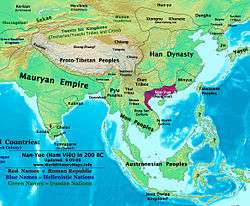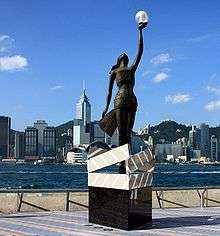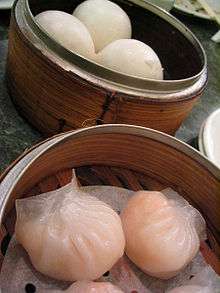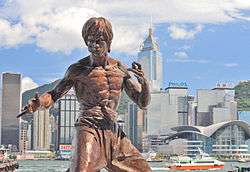Cantonese people
| Cantonese people | |||||||||||||
| Traditional Chinese | 廣府人 | ||||||||||||
|---|---|---|---|---|---|---|---|---|---|---|---|---|---|
| Simplified Chinese | 广府人 | ||||||||||||
| |||||||||||||
| Alternative Chinese name | |||||||||||||
| Traditional Chinese | 廣東人 | ||||||||||||
| Simplified Chinese | 广东人 | ||||||||||||
| |||||||||||||
Cantonese people (simplified Chinese: 广府人; traditional Chinese: 廣府人; Jyutping: gwong2 dung1 jan4; Hanyu: Guǎngdōng Rén; lit. people of Guangdong) are Han Chinese people originating from or residing in Guangdong Province, China, formerly romanised as Canton Province. The term "Cantonese people" is often synonymous with the Punti (本地; bun2 dei6) people. They are also referred to as "Kongfu" in Malaysia and "Konghu" in Indonesia[5] and as "Hoa" in Vietnam.
The Cantonese people were historically responsible for establishing the Cantonese language's usage in Hong Kong during the early migration to the colonial era. Today, Hong Kong and Macau are the only regions in the world where Cantonese is the official spoken language; most people in Guangdong, as elsewhere in Mainland China, speak Mandarin in addition to Cantonese.
Taishanese people (四邑廣東人) may also be considered as Cantonese, but speak Taishanese (台山話), a different variant of Yue Chinese.
There have been a number of influential Cantonese figures throughout history, such as Bruce Lee, Ching Shih, Lee Shau-kee, Ho Ching, and Flossie Wong-Staal.
History

Pre-19th century: History of Guangdong
Until the 19th century, Cantonese history was largely the history of Guangdong.
What is now Guangdong was first brought under Qin influence by a Qin dynasty general named Zhao Tuo who later founded the kingdom of Nanyue in 204 BC.[6][7][8][9][10] The Nanyue kingdom went on to become the strongest Baiyue state in China, with many neighboring kingdoms declaring their allegiance to Nanyue rule. Zhao Tuo took the Han territory of Hunan and defeated the Han dynasty's first attack on Nanyue, later annexing the kingdom of Minyue in the East and conquering Âu Lạc, Northern Vietnam, in the West in 179 BC.[11]
The greatly expanded Nanyue kingdom included the territories of modern-day Guangdong, Guangxi, and Northern Vietnam, with the capital situated at modern-day Guangzhou. The native people of Guangdong remained under Baiyue control until the Han dynasty in 111 BC, following the Han–Nanyue War. However, it was not until subsequent dynasties such as the Jin Dynasty, Tang Dynasty and Song Dynasty that major waves of Han Chinese began to migrate into Guangdong. Waves of migration and subsequent intermarriage meant that existing populations of Guangdong were displaced, but some native groups like the Zhuang still remained. The Cantonese often call themselves "people of Tang". This is because of the Inter-mixture between native and Han immigrants in Guangdong reached a critical mass of acculturation during the Tang dynasty, creating an new local identity among the Guangdong people.[12]
During the 4th-12th centuries, Han Chinese people from Northern China's Yellow River valley migrated and settled in the South of China. This gave rise to peoples including the Cantonese, Hakka, and Hoklo, whose ancestors migrated from Henan Province to areas of Southeastern coastal China such as Chaozhou, Quanzhou, and Zhangzhou during the Tang dynasty.[13] There have been multiple migrations of Han people into Southeastern and Southern China throughout history.[14]
The origin of the Cantonese people is thus said to be Northern Chinese peoples that migrated to Guangdong while it was still inhabited by Baiyue peoples.[15] During Wang Mang's reign in the Han dynasty (206BC-220AD), there were influxes of Han Chinese migrants into Guangdong, Vietnam, and Yunnan.[16]
19th-20th century: Turmoil and migration
During the early 1800s, conflict occurred between Cantonese and Portuguese pirates in the form of the Ningpo massacre.[17] The First (1839–1842) and Second Opium Wars (1856–1860) led to the loss of China's control over Hong Kong and Kowloon, which were ceded to the British. Macau also became a Portuguese settlement. Between 1855 and 1867, the Punti-Hakka Clan Wars caused further discord in Guangdong. The third plague pandemic of 1855 broke out in Yunnan and spread to Guangdong, killing thousands and spreading via water traffic to nearby Hong Kong.
The turmoil of the 19th century, followed by the political upheaval of the early 20th century, compelled many residents of Guangdong to migrate overseas. Up until the second half of the 20th century, the majority of overseas Chinese emigrated from two provinces of China; Guangdong and Fujian. As a result, there are today many Cantonese communities throughout the world, including in North America, Latin America, the Caribbean, Southeast Asia, East Africa, the United Kingdom, and the Pacific Islands, with Chinatowns commonly being established by Cantonese communities. There have been a large number of interracial marriages between Cantonese men and women from other countries, as most of the migrants from Guangdong were men. Resultantly, there are many Eurasians with Cantonese ancestry,[18] for example Nancy Kwan, born to a Cantonese father and Scottish mother is a well-known Hollywood actress in the 1960s; and influential martial artist Bruce Lee, who was born to a Cantonese father and a half-Chinese, half-Caucasian mother.
Unlike the migrants from Fujian, who mostly settled in Southeast Asia, many Cantonese emigrants migrated to the Western Hemisphere, particularly the United States and Canada. Many Cantonese immigrants into the United States became railroad labourers, while many in South America were brought in as coolies. Cantonese immigrants in California participated in the California Gold Rush and the Australian gold rushes of 1854 onwards, while Chinese in Hawaii found employment in sugar plantations as contract labourers. These early immigrants variously faced hostility and a variety of discriminatory laws, including the prohibition of Chinese female immigrants. The relaxation of immigration laws after World War II allowed for subsequent waves of migration to the United States from both mainland China and Hong Kong, while the majority of the Chinese-Vietnamese boat people from the Vietnam War spoke Cantonese either as a first or secondary language. As a result, Cantonese continues to be widely used by Chinese communities of Guangdong and Hong Kong origin in the Western hemisphere, and has not been supplanted by Standard Chinese. A large proportion of the early migrants also came from the Siyi region of Guangdong and spoke Taishanese. The Taishan dialect is still spoken in American-Chinese communities, by the older population as well as by more recent immigrants from Taishan.
Cultural hub
Cantonese people and their culture hub are centred in Guangdong, Hong Kong, and Macau.
Guangzhou, the capital city of Guangdong, has been one of China's international trading ports since the Tang dynasty. During the 18th century, it became an important centre of the emerging trade between China and the Western world, as part of the Canton System. The privilege during this period made Guangzhou one of the top three cities in the world.[19] Operating from the Thirteen Factories located on the banks of the Pearl River outside Canton, merchants traded goods such as silk, porcelain ("fine china"), and tea, allowing Guangzhou to become a prosperous city. Links to overseas contacts and beneficial tax reforms in the 1990s have also contributed to the city's ongoing growth. Guangzhou was named a global city in 2008. The migrant population from other provinces of China in Guangzhou was 40 percent of the city's total population in 2008. Most of them are rural migrants and they speak only Mandarin.[20]
Hong Kong and Macau are two of the richest cities in the world in terms of GDP per capita and are autonomous SARs (Special Administrative Regions) that are under independent governance from China. Historically governed by the British and Portuguese empires respectively, colonial Hong Kong and Macau were increasingly populated by migrant influxes from mainland China, particularly the nearby Guangdong Province. For that reason, the culture of Hong Kong and Macau became a mixture of Cantonese and Western influences, sometimes described as "East meets West".
Hong Kong
![]()
Hong Kong native peoples include the Hakka and Tanka, who speak their own dialects. Another dialect traditionally spoken is Weitou.
Hong Kong Island was first colonised by the British Empire in 1842 with a population of only 7,450; however, it was in 1898 that Hong Kong truly became a British colony, when the British also colonised the New Territories (which constitute 86.2% of Hong Kong's modern territory). It was during this period that migrants from China entered, mainly speaking Cantonese (the prestige dialect of Yue Chinese) as a common language. During the following century of British rule, Hong Kong grew into a hub of Cantonese culture, and has remained as such since the handover in 1997.
Today Hong Kong is one of the world's leading financial centres, and the Hong Kong dollar is the thirteenth most traded currency in the world.
Macau
![]()
Macau native people are known as the Tanka. A dialect similar to Shiqi (石岐話), originating from Zhongshan (中山) in Guangdong, is also spoken in the region.
Parts of Macau were first loaned to the Portuguese by China as a trading centre in the 16th century, with the Portuguese required to administrate the city under Chinese authority. In 1851 and 1864, the Portuguese Empire occupied the two nearest offshore islands Taipa and Coloane respectively, and Macau officially became a colony of the Portuguese Empire in 1887. Macau was returned to China in 1999.
By 2002, Macau had become one of the world's richest cities,[21] and by 2006, it had surpassed Las Vegas to become the world's biggest gambling centre.[22] Macau is also a world cultural heritage site due to its Portuguese colonial architecture.
Culture





The term "Cantonese" is used to refer to the native Guangdong people, their language, or culture.[23]
Language
The term "Cantonese language" is sometimes used to refer to the broader group of Yue Chinese dialects spoken in Guangdong and Guangxi, although it is also used more specifically to describe Guongzauwaa (廣州話), the prestige dialect of Cantonese spoken in Guangdong, Hong Kong and Macau. Guongzauwaa is the language used for education and media in Hong Kong and Macau. However, it is not as widely used in Guangzhou, where a large proportion of the population is made up by migrant workers from elsewhere in China that speak Mandarin and other Chinese dialects.[24]
Because of its tradition of usage in music, cinema, literature, newspapers and manhua, this form of Cantonese is a cultural mark of identity that distinguishes Cantonese people from Mainland Chinese. The pronunciation and vocabulary of Cantonese has preserved many features of the official language of the Tang dynasty with elements of ancient Yue language.[25]
Arts
Cantonese opera also has a long tradition that may date back to the Song dynasty in the 13th century.
Due to its political and economic status outside of the direct control of the People's Republic of China, Hong Kong has been a production centre of Cantonese-language entertainment in the 20th century. This includes Cantopop (well-known artists include Andy Lau, Aaron Kwok, Joey Yung, Alan Tam, Roman Tam, Danny Chan, Jacky Cheung, Leon Lai, Faye Wong, Sammi Cheng, and Coco Lee; many of whom are of Cantonese or Taishanese origin) and Cantonese-language cinema (recent films include Kung Fu Hustle, Infernal Affairs, and Ip Man 3). The Hong Kong movie industry was the third-largest movie industry in the world (after Hollywood and Bollywood) for decades throughout the 20th century, with Cantonese-language films viewed and acclaimed around the world.
Cuisine
Cantonese cuisine has become one of the most renowned types of cuisine around the world, characterised by its variety of cooking methods and use of fresh ingredients, particularly seafood.[26] One of the most famous examples of Cantonese cuisine is dim sum, a variety of small dishes such as har gow (steamed shrimp dumplings), siu mai (steamed pork dumplings), and cha siu bao (barbecued pork buns).
Notable figures
The following is an incomplete list of notable figures and celebrities that are regarded as being of Cantonese origin:
Historical
- Liu Yan, king of Nanhai and first emperor of the Yue/Han kingdom between 917–971
- Chen Zuyi, 14th-century pirate operating in the seas of Southeast Asia
- Yuan Chonghuan, Ming dynasty general and patriot famed for defeating Qing dynasty rulers Nurchaci and Hong Taiji
- Liang Daoming, king of Palembang during the Ming dynasty
- Ching Shih, one of the world's most powerful pirates; she challenged the British empire, Portuguese empire, and Qing dynasty and was undefeated[27][28]
- Cheng I, pirate and husband of Ching Shih
- Ah Pak, pirate chieftain who defeated Portuguese pirates
- Liu Chang, the last emperor of the Southern Han Kingdom
- Mạc Cửu, ruler of Hà Tiên in the 18th century; played a role in the relations between Cambodia and Vietnam
- Deng Shichang, admiral and one of the first modern naval officers in China in the late Qing dynasty
- Tse Tsan-tai, early Chinese revolutionary of the late Qing Dynasty
- Liang Qichao, scholar and reformist in the late Qing dynasty and early Republic of China
- Jiang Guangnai, general and statesman in the Republic of China and the People's Republic of China who successfully defended Shanghai from the Japanese invasion in the January 28 Incident of 1932
Entertainers
- Anna May Wong, the first Chinese-American and Asian female international movie star
- Hu Die, famous Chinese actress during the 1920s-30s
- James Wong Howe, leading Hollywood cinematographer in the 1930s-40s and ten-time Academy Award nominee
- Lai Man-Wai, the father of Hong Kong cinema
- Stephen Chow, His grandfather is from Ningbo but his mother is Cantonese. He is actor and film director known for the comedy blockbusters Shaolin Soccer and Kung Fu Hustle
- John Woo, influential film director
- Tony Leung Chiu-wai, award-winning actor known for his collaborations with Wong Kar-wai, including In The Mood For Love
- Andy Lau, one of Hong Kong's most commercially successful singers and actors since the mid-1980s
- Gigi Lai, actress and Cantopop singer
- Aaron Kwok, dancer and singer since the early 1990s
- Amy Kwok, actress and Miss Hong Kong 1991
- Eason Chan, well-known Cantopop singer
- Rainie Yang, Taiwanese singer
- Vivian Chow, Cantopop singer and actress
- Fish Leong, Malaysian-Chinese singer
- Kris Wu, Chinese-Canadian actor and singer. He is a former member of Korean boy band EXO.
- Jackson Wang member of the group GOT7
- Louis Koo, Hong Kong actor
- Tony Leung Ka Fai, Hong Kong actor
- Cheung Ka Fai, Hong Kong actor
Politicians
- Donald Tsang, chief executive of Hong Kong
- Edmund Ho Hau Wah, chief executive of Macau
- Fernando Chui, chief executive of Macau
- Wu Tingfang, China's foreign minister during the Qing dynasty
- Wen Tsung-yao, politician and diplomat in the Qing dynasty and Republic of China
- Hiram Fong, the first Asian-American and Chinese to be elected as Republican United States Senator and nominated for presidency of the United States
- John So, the first Lord Mayor of Melbourne to be directly elected by the people in 2006, and the first mayor of Asian descent
- Norman Kwong, the 16th Lieutenant Governor of Alberta, Canada
- Edmund Ho, the first Chief Executive of Macau
- Gary Locke, the first governor of a state in the Continental United States of Asian descent; the only Chinese American ever to serve as a governor
- Judy Chu, the first Chinese-American woman to be elected to the United States Congress
- Julius Chan, Prime Minister of Papua New Guinea from 1980 to 1982, and from 1994 to 1997
- Lee Siew Choh, politician and medical doctor. Singapore's first Non-Constituency Member of Parliament (NCMP)
- Peter Chin, lawyer and 56th Dunedin, New Zealand mayor
- John Yap, Canadian politician
- Meng Foon, mayor of Gisborne, New Zealand
- Alan Lowe, architect, former mayor of Victoria, British Columbia, Canada
- Ida Chong, accountant, former municipal councilor of Saanich, British Columbia, former cabinet minister/Member of Legislative Assembly of British Columbia, Canada
Sportspeople
- Wong Peng Soon, A renowned male badminton player in the latter half of the 20th century
- Patrick Chan, A world champion Chinese-Canadian male figure skater
- Michelle Kwan, Chinese-American female figure skater and five-time world champion
- Yi Jianlian, a 7-foot-tall Chinese basketball player for NBA, Milwaukee Bucks, New Jersey Nets, and Washington Wizards
- Guan Weizhen, female badminton player who won three consecutive women's doubles titles at the BWF World Championships
- Chen Xiaomin Chinese retired weightlifter, in 2000 Sydney Olympics on the women's weightlifting gold medal, also a world and Asian champion
- Shanshan Feng, The first golfer from China to win LPGA major championship and major championship, she was ranked fifth in 2012 Women's World Golf Rankings.[29]
- He Chong, Chinese, diver. He is the 2008 Olympic Champion gold medalist in the 3m springboard. He was unbeaten from 2006 - 2016
- Jiang Jialiang, Table Tennis player, he won medals in Asia and world table tennis tournaments.
- Xie Xingfang, Badminton player, she is a two-time world champion women's singles.
- Chen Xiexia, She won three golds at the 2007 World Weightlifting Championships. The first gold medal for China in the 2008 Summer Olympics.
- Zhang Jiewen, Gold medal in Badminton 2004 Athens
- Lao Lishi, Gold medal in women's 10 meter synchronized platform along with Li Ting.
- Su Bingtian, He is the reigning Asian champion over 100 metres, was a semi-finalist at the 2012 Summer Olympics and a finalist at the 2015 World Championships.
- Liang Wen-Chong, Highest ranked golfer from the People's Republic of China, the only Chinese golfer to have reached the top 100 of the Official World Golf Ranking.
Businesspeople
- Raymond, Thomas, and Walter Kwok, brothers whose property business makes them the fourth richest in Hong Kong[30]
- Lui Che-woo, real estate and hospitality magnate at one time the second richest man in Asia
- Mei Quong Tart, nineteenth-century merchant and personality in Sydney
- Charles Sew Hoy, merchant and gold-dredging pioneer in New Zealand
- Loke Yew, businessman and philanthropist in British Malaya
- Chin Gee Hee, merchant and railway entrepreneur
- Lee Shau-kee, real estate tycoon and owner of Henderson Land Development, the 4th world richest person in world before the handover of HK in 1997
- Ho Ching, First Lady of Singapore and 59th most powerful woman in the world in 2014
- Steven Lo, businessman and football team manager
- Jimmy Lai, founder of Giordano
Martial artists
- Wong Fei-hung, martial artist in the Qing dynasty, the subject of numerous films and television series
- Yip Man, martial artist and teacher of Bruce Lee; inspired the Ip Man film series, among other biographical adaptations
- Bruce Lee, one of the most influential martial artists of all time
- Chan Heung, founder of Choy Li Fut
- Donnie Yen, martial artist and actor
Academics
- Flossie Wong-Staal, Chinese-American virologist and molecular biologist; the first scientist to clone HIV and determine the function of its genes in 1985
- Chu Ching-wu, physicist and one of the first scientists to demonstrate high-temperature superconductivity, in 1987
- Choh Hao Li, Chinese-American biochemist and first scientist to synthesise human growth hormone in 1970
- Wu Ta-You, the "father of Chinese physics"
- Wu Lien-teh, physician and Nobel prize nominee
- Nancy Ip, biologist specialising in neuroscience
- Vivian Wing-Wah Yam, chemist known for her work on light-emitting materials and solar energy
- Albert Chan, professor of chemistry and traditional Chinese medicine
- Liang Sili, rocket and missile control system scientist
Other notable figures
- Feng Joe Guey, Chinese aviation pioneer
- Liang Sicheng, the "father of modern Chinese architecture"
- Dai Ailian, the "mother of Chinese modern dance"
- Lee Ya-Ching, pioneering aviator and actress
Cantonese influence on the Xinhai Revolution
The Xinhai Revolution of 1911 was a revolution that overthrew the last imperial dynasty of China, the Qing dynasty, and established the Republic of China. Guangdong's uprising against the Qing dynasty in 1895 let to its naming as the "cradle of the Xinhai Revolution".[31][32][33] Revolutionary leader Sun Yat-sen was born in Zhongshan, Guangdong.[34][35] Hong Kong was where he developed his thoughts of revolution and was the base of subsequent uprisings, as well as the first revolutionary newspaper.[36][37] Sun Yat-sen's revolutionary army was largely made up of Cantonese, and many of the early revolutionary leaders were also Cantonese.[38]
See also
- Chinese people
- Han Chinese
- Punti-Hakka Clan Wars
- Cantonese people in Hong Kong
- Cantonese
- Cantonese cuisine
References
- ↑ David P Brown (31 August 2011). "Top 100 Languages by Population". Retrieved 6 May 2016.
- 1 2 3 https://www.ethnologue.com/language/yue
- ↑ CIA World Factbook. Cuba. 2008. May 15, 2008. <https://www.cia.gov/library/publications/the-world-factbook/geos/cu.html>.
- ↑ http://convergencia.uaemex.mx/rev38/38pdf/LIZCANO.pdf
- ↑ Chinese Overseas: Comparative Cultural Issues. Hong Kong University Press. pp. 92–93.
- ↑ Sima Qian, Records of the Grand Historian, section 112.
- ↑ Huai Nan Zi, section 18
- ↑ Zhang & Huang, pp. 26–31.
- ↑ Zhang and Huang, pp. 196–200; also Shi Ji 130
- ↑ Records of the Grand Historian, section 97 《《史記·酈生陸賈列傳》
- ↑ Chapuis, Oscar (1995). A History of Vietnam: From Hong Bang to Tu Duc. Greenwood Publishing Group. pp. 13–14. ISBN 0-313-29622-7.
- ↑ Ramsey, S. Robert (1987). The Languages of China. Princeton University Press. pp. 98–99. ISBN 0-691-06694-9.
- ↑ Sow-Theng Leong; Tim Wright; George William Skinner (1997). Migration and Ethnicity in Chinese History: Hakkas, Pengmin, and Their Neighbors. Stanford University Press. pp. 78–. ISBN 978-0-8047-2857-7.
- ↑ Jacques Gernet (31 May 1996). A History of Chinese Civilization. Cambridge University Press. pp. 8–. ISBN 978-0-521-49781-7.
- ↑ Shmuel Noah Eisenstadt; Wolfgang Schluchter; Björn Wittrock. Public Spheres and Collective Identities. Transaction Publishers. pp. 213–4. ISBN 978-1-4128-3248-9.
- ↑ Jacques Gernet (31 May 1996). A History of Chinese Civilization. Cambridge University Press. pp. 126–. ISBN 978-0-521-49781-7.
- ↑ Zhidong Hao (2011). Macau History and Society (illustrated ed.). Hong Kong University Press. p. 67. ISBN 988-8028-54-5. Retrieved 4 November 2011.
There was indeed a group of Portuguese who became pirates, called "Macau ruffians," or policemen who turned bad, along with "Manila-men" from the Philippines and escaped African slaves. Their fleet attacked "the Cantonese ships when they could get them at an advantage, and murdered their crews with circumstances of great atrocity."55 They were destroyed in Ningbo by a fleet of Chinese pirates with the support of the local Chinese government and other Europeans.
- ↑ "UK Chinese". Retrieved 6 May 2016.
- ↑ "Top 10 Cities of the Year 1800". About.com. Retrieved 2008-08-28.
- ↑ Branigan, Tania (2010-07-25). "Protesters gather in Guangzhou to protect Cantonese language". The Guardian. London.
- ↑ Macau has become known as the 'Las Vegas of the Far East'. Papers by Cindia Ching-Chi
- ↑ Barboza, David (2007-01-23). "Macao Surpasses Las Vegas as Gambling Center". The New York Times.
- ↑ Unity and diversity: local cultures and identities in China By David Faure
- ↑ "Migrants In Guangzhou". Retrieved 6 May 2016.
- ↑ South China Morning Post. [2009] (2009). 11, October. "Linguistic heritage in peril". By Chloe Lai.
- ↑ Cuisine and Culture: A History of Food and People. p. 281.
- ↑ http://www.thewayofthepirates.com/pirate-life/10-pirate-captains.php
- ↑ Lily Xiao Hong Lee, A. D. Stefanowska, Clara Wing-chung Ho - 2003 - 387 pages
- ↑ "Women's World Golf Rankings". Rolex Rankings. 11 June 2012. Retrieved 11 June 2012.
- ↑ "Thomas & Raymond Kwok". Forbes. Retrieved 2016-07-05.
- ↑ "Nation, Governance, and Modernity in China". Retrieved 6 May 2016.
- ↑ Langmead, Donald. [2011] (2011). Maya Lin: A Biography. ABC-CLIO publishing. ISBN 0313378533, 9780313378539. pg 5–6.
- ↑ 1010. "辛亥革命研究專家章開沅:"廣東是革命搖籃"". Retrieved 6 May 2016.
- ↑ Saltwater City: An Illustrated History of the Chinese in Vancouver By Paul Yee
- ↑ F_467. "Chinese community in Houston marks centenary of 1911 Revolution". Retrieved 6 May 2016.
- ↑ Hong Kong public libraries Leisure and Cultural Services Department
- ↑ "香港为何成辛亥革命摇篮_时政频道_新华网". Retrieved 6 May 2016.
- ↑ Shanghai on Strike: The Politics of Chinese Labor By Elizabeth J. Perry
- David Faure; Helen F. Siu (1995). Down to earth: the territorial bond in South China. Stanford University Press. ISBN 978-0-8047-2435-7.